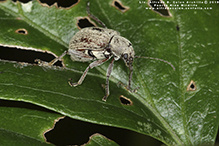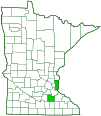grape rootworm
(Neofidia lurida)
Conservation • Description • Habitat • Ecology • Distribution • Taxonomy
|
|
||||||||||||||
Description |
Grape rootworm is a small beetle but a medium-sized oval leaf beetle. It occurs in North America and Mexico. In the United States it occurs from Connecticut west to North Dakota and south to Texas. Based on the number of reported observations, it is uncommon throughout its range, including in Minnesota. Larvae feed on the roots of of wild grape, silverleaf grape, woodbine, and Virginia creeper. Adults feed on the leaves of the same plants. Adults are oblong, 3⁄16″ to ¼″ (4.9 to 7.0 mm) long, and ⅛″ (2.5 to 3.5 mm) wide. They are entirely dark reddish-brown and are densely covered with grayish or yellowish hairs. The body is oval with straight sides along the middle when viewed from above, and convex when viewed from the side. The head and mouthparts are directed downward. The forehead (frons) merges with the top of the head (vertex) and is not well differentiated. The antennae are thread-like and long, half to three-quarters as long as the body. They have 11 segments. The second segment is shorter than but more than half as long as the first. It is also shorter than the next four or five segments. The compound eyes are not notched. The exoskeletal plate covering the thorax (pronotum) is slightly longer than wide. It does mot have flattened lateral margins. It narrower than the base of the hardened wing covers (elytra). The elytra are ridged and have rows of deep pits (punctures). The legs are long, slender, and entirely dark reddish-brown. The third segment (femur) of each leg is slightly thickened and does not have a tooth on the underside. The fourth segment (tibia) has a raised, longitudinal ridge (carina) along its length and a pair of small spurs at the tip. The last part of the leg (tarsus) has 5 segments, but the fourth segment is very small and is concealed within the lobes at the end of the third segment, making it appear to have just 4 segments. There are two claws at the end of the tarsus. Each claw is cleft at the end (bifid). |
Size |
Total length: 3⁄16″ to ¼″ (4.9 to 7.0 mm) |
Similar Species |
Habitat |
Wild grape, silverleaf grape, woodbine, and Virginia creeper |
Ecology |
Season |
One generation per year: Late May to August |
Behavior |
|
Life Cycle |
The female deposits an egg under the bark of a host plant. When the egg hatches, the larva (grub) drops to the ground, burrows into the soil, and feed on the roots of the host plant. The grub overwinters in the soil. The adult emerges in late May to early July and feeds on foliage of the host. The adult lives about one month. |
Larva Food |
Roots of wild grape, silverleaf grape, woodbine, and Virginia creeper |
Adult Food |
Leaves of wild grape, silverleaf grape, woodbine, and Virginia creeper |
Distribution |
||
|
Sources |
|
| 11/29/2024 | ||
Occurrence |
||
|
||
Taxonomy |
|
Order |
Coleoptera (Beetles) |
Suborder |
Polyphaga (Water, Rove, Scarab, Long-horned, Leaf, and Snout Beetles) |
Infraorder |
Cucujiformia |
Superfamily |
Chrysomeloidea (leaf beetles and allies) |
Family |
Chrysomelidae (leaf beetles) |
Subfamily |
Eumolpinae (oval leaf beetles) |
Tribe |
Bromiini |
Genus |
Neofidia |
Genus Tribe |
|
Subordinate Taxa |
|
|
|
Synonyms |
|
Colaspis flavescens Fidia lurida (?) Fidia viticida Neofidia viticida |
|
Common Names |
|
grape rootworm |
|
Glossary
Elytra
The hardened or leathery forewings of beetles used to protect the fragile hindwings, which are used for flying. Singular: elytron.
Femur
On insects and arachnids, the third, largest, most robust segment of the leg, coming immediately before the tibia. On humans, the thigh bone.
Frons
The upper front part of an insect’s face, roughly corresponding to the forehead.
Pronotum
The exoskeletal plate on the upper side of the first segment of the thorax of an insect.
Tarsus
On insects, the last two to five subdivisions of the leg, attached to the tibia; the foot. On spiders, the last segment of the leg. Plural: tarsi.
Vertex
The upper surface of an insect’s head.
Visitor Photos |
||
Share your photo of this insect. |
||
This button not working for you? |
||
Alfredo Colon |
||
 |
 |
|
MinnesotaSeasons.com Photos |
||
|
||
|

Slideshows |
|

Visitor Videos |
||
Share your video of this insect. |
||
This button not working for you? |
||
|
Other Videos |
||
Grape Worms |
About
Sep 21, 2019 Grape Root Worms Grape rootworms are pests of grapes and related host species, such as Virginia creeper and redbud. They are common from the Atlantic seaboard states to North Dakota, Nebraska, Kansas, and Texas. Adult beetles emerge anywhere from late May to mid-July, depending on the soil temperature. They are 8-10 mm long and hairy grayish brown or chestnut in color. They feed on the plants and leave chainlike feeding marks. The females lay eggs under the bark of grape vines and the larvae devour small roots and eat pits in the outer portion of larger roots. These creamy white larvae with dark brown heads are particularly destructive to vine health. https://www.arbico-organics.com/product/grape-root-worms/problem-solver-guide |

Created: 11/18/2020 Last Updated: © MinnesotaSeasons.com. All rights reserved. |



